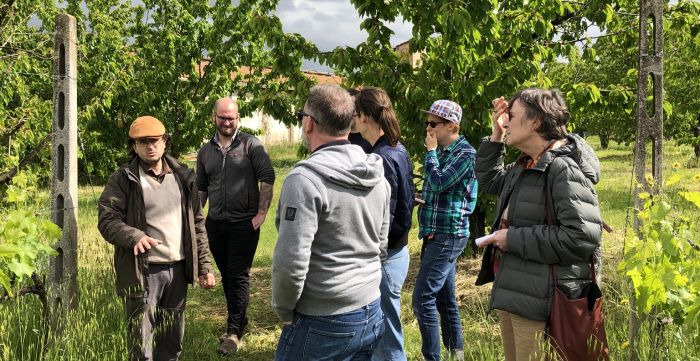
producer profile
06.10.2020
Fattoria Mani di Luna Producer Profile
<p>Fattoria Mani di Luna was born in 2012 as the joint effort of three long-time friends, Simone, Rocco and Alessandro (Alessandro and Rocco played in a band together for years and Rocco and Simone were classmates in Perugia studying agronomy). Their shared love of nature and <span class="zalup"><span><glossary term="Agriculture" title="78">agriculture</glossary><span>,</span></span></span> coupled with a desire to rejuvenate the soil and vines through <glossary term="Organic" title="746">organic</glossary> and <glossary term="Biodynamic" title="160">biodynamic</glossary> practices, is the driving force behind the project. The vines are <glossary term="Organic Certification" title="260">certified</glossary> <span class="zalup"><span><glossary term="Organic" title="746">organic</glossary><span>,</span></span></span> but the friends make use of <glossary term="Biodynamic" title="160">biodynamic</glossary> preparations, <glossary term="Compost" title="323">composts</glossary> and adhere to the lunar cycles in <glossary term="Viticulture" title="1103">viticulture</glossary> and production. In their eyes, <glossary term="Biodynamic" title="160">biodynamics</glossary> allows for the vineyard to express itself better. The healthy grapes are imprinted with the natural rhythms of a growing season, which prepares them for “good” <span class="zalup"><span><glossary term="Fermentation" title="441">fermentations</glossary><span>.</span></span></span> This allows Simone, Rocco and Alessandro to eschew significant manipulation of the grapes in the winery.</p>
<p>The <glossary term="Estate" title="427">estate</glossary> is composed of 35 <glossary term="Hectare" title="523">hectares</glossary> (7.5 planted to vine) located in <span class="zalup"><span><glossary term="Torgiano" title="1329">Torgiano</glossary><span>,</span></span></span> an area of Italy that can trace its grape growing traditions to the ancient Etruscans. The property that the friends acquired has history in the region. Prior to their revival of the land, it was owned by the famed Lungarotti family. Some of the vines are planted on the flats near the confluence of the Chiascio River with the Tiber. The remainder are on the hills overlooking the winery at an altitude between 200 and 400 meters. The soil is largely composed of <glossary term="Sand" title="909">sand</glossary> with <glossary term="Sandstone" title="910">sandstone</glossary> and <glossary term="Calcareous" title="222">calcareous</glossary> <span class="zalup"><span><glossary term="Marl" title="632">marl</glossary><span>.</span></span></span> The <glossary term="Sand" title="909">sandy</glossary> soil is essential for maintaining low <glossary term="PH" title="783">PH</glossary> and high <glossary term="Acidity" title="71">acidity</glossary> even when the grapes reach higher sugar levels.</p>
<p>Everything is <span class="zalup"><span><glossary term="Hand Harvesting" title="520">harvested by hand</glossary><span>.</span></span></span> Most of the grapes are <glossary term="De-stemming" title="378">destemmed</glossary> by hand to better protect the integrity of the fruit. Keeping with the traditional methods, most of the grapes are <glossary term="Foot-Treading" title="458">foot-tread</glossary> and all the wines see significant <glossary term="Lees" title="590">lees</glossary> contact with regular <span class="zalup"><span><glossary term="Battonage" title="147">bâtonnage</glossary><span>.</span></span></span> Everything is done by hand with great care. <glossary term="Sulfites" title="993">Sulfur</glossary> is only added if it is absolutely necessary. </p>
Article
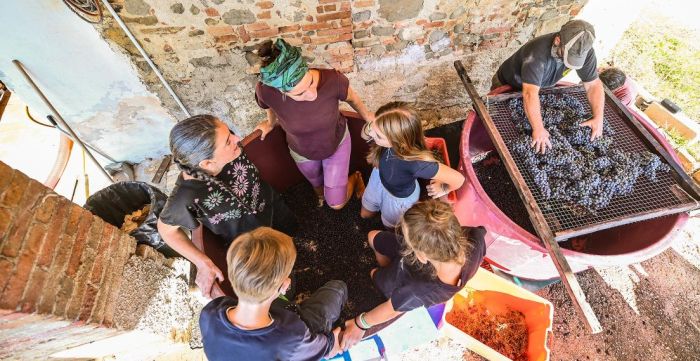
harvest report
05.11.2024
2024 Harvest Report from Fattoria Mani di Luna
<p>The 2024 season began with a cold and rainy spring, similar to the 2023 vintage, but with fewer problems due to downy mildew than the previous year. The vegetation grew very quickly in the months of May and June, requiring a lot of manual work in the vineyard to arrange the shoots and a total of 11 treatments with copper, sulfur, zeolite, infusions and/or decoctions of horsetail and nettle, which ended around mid-July.</p>
<p><br />
By the end of June, the climate changed drastically, with scorching temperatures between 35 and 40 degrees and no rain until early September. This lead the plants to a state of suffering, first from excessive heat with obvious leaf burns and then (in August) due to drought. The rains returned on Septmember 8th, outlining the moments of the harvest and slowed down the ripening which seemed to proceed too quickly.</p>
<p><br />
The grape yields per hectare were balanced (5000-7000 kg per hectare) and we managed to harvest the grapes at the right ripeness without having too high a sugar level. The harvest began on August 28 and ended on October 2 with a total of about 34,000 kg of grapes harvested.</p>
<p><br />
The grapes were very different depending on the exposure and soil, so a lot of monitoring and tasting was done to evaluate the right degree of ripeness. Some fermentations went quickly and others went very slowly depending on how much the vines suffered. In November, in the vineyards where the vines suffered the most from drought, in addition to the usual green manure we distributed earthworm humus to increase the water retention capacity of the soil. The fermentations proved to be a perfect indicator of the degree of stress of the vines.</p>
<p><br />
As always we had fun destemming by hand and pressing with our feet: 8000 Kg of Sangiovese, Barbera and Canaiolo Nero. The wines seem to have excellent aromas and a beautiful energy...we will observe their evolution over the months in the different containers (cement, stainless steel, fiberglass, wood and terracotta amphorae) always with the amazed and caring eyes of a parent full of love who lets their children express themselves freely with joy!</p>
<p style="text-align:justify; margin:0in 0in 10pt"><img src="https://louisdressner.com/uploads/images/article//1023/95/5f/955f2c63eb43940731b945bb08329bfb.jpg" /><img src="https://louisdressner.com/uploads/images/article//1023/c3/ea/c3eaf250f80a3c51602f3ecb621f1104.jpg" /><img src="https://louisdressner.com/uploads/images/article//1023/55/7a/557a12bafc0302610f760b2a592e1b03.jpg" /><img src="https://louisdressner.com/uploads/images/article//1023/e6/84/e684543b576ad080e948883787c37a76.jpg" /><img src="https://louisdressner.com/uploads/images/article//1023/23/58/2358b49e5e55f31a63a79bc5dc4fc96b.jpg" /><img src="https://louisdressner.com/uploads/images/article//1023/8b/5c/8b5c7462a3a99335b34b998e9ce3de2c.jpg" /><img src="https://louisdressner.com/uploads/images/article//1023/38/07/38078844794cd43a8d78b852634fd3c3.jpg" /><img src="https://louisdressner.com/uploads/images/article//1023/ab/c4/abc4c97444c7b0ec24094dca1dc1ad45.jpg" /><img src="https://louisdressner.com/uploads/images/article//1023/43/f8/43f83231c9ce4c79b17a78560f4fc892.jpg" /><img src="https://louisdressner.com/uploads/images/article//1023/be/07/be07c033555662535f5047ac2ac44e32.jpg" /><img src="https://louisdressner.com/uploads/images/article//1023/80/b8/80b84af3809051cd189f9b229c625099.jpg" /><img src="https://louisdressner.com/uploads/images/article//1023/1d/ab/1dab6e67edebaf7664901a60fade80ec.jpg" /><img src="https://louisdressner.com/uploads/images/article//1023/4c/af/4cafac5794fbf8402942d97f3d3de879.jpg" /><img src="https://louisdressner.com/uploads/images/article//1023/4b/ba/4bba6c140bd0ccc2645a4ff49702c22f.jpg" /><img src="https://louisdressner.com/uploads/images/article//1023/a3/8e/a38e5232eb568f0a139fc4b935fc1225.jpg" /></p>
Article
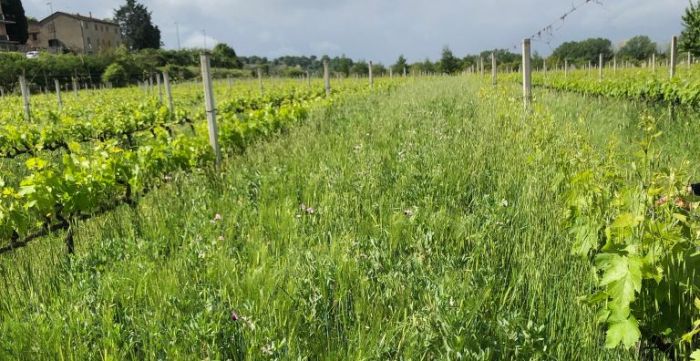
harvest report
23.12.2022
2022 Harvest Report from Mani di Luna
<p>The spring and beginning of summer 2022 was very dry and hot so we made only four <glossary term="Contact Treatment" title="328">treatments</glossary> in the vineyards; no <glossary term="Sulfites" title="993">sulphur</glossary> and very little <span class="zalup"><span><glossary term="Copper" title="333">copper</glossary><span>,</span></span></span> zeolite, nettle and horsetail teas. In mid-August, it started to rain a little, then again in September. These rains allowed the white grapes to ripen slowly; for the red varieties (<glossary term="Sangiovese" title="911">Sangiovese</glossary> and <glossary term="Barbera" title="138">Barbera</glossary>), the rain was not needed as the grapes were already ripe due to the excessive temperatures of July and August.</p>
<p>So we started <glossary term="Harvest" title="521">harvesting</glossary> the <glossary term="Sangiovese" title="911">Sangiovese</glossary> for the "Rosé Osé" on August 31st, the <glossary term="Barbera" title="138">Barbera</glossary> for "Checcarello" on September 6th and the <glossary term="Sangiovese" title="911">Sangiovese</glossary> for the others red wines between September 14th and 20th. It was a very fast period of hard work!</p>
<p>For the white varieties, we started the <glossary term="Grechetto" title="505">Grechetto</glossary> <glossary term="Harvest" title="521">harvest</glossary> for the "GRE GLU" on September 6th, then on September 10th, <glossary term="Riesling" title="858">Riesling</glossary> and <glossary term="Grechetto" title="505">Grechetto</glossary> for the first of two 600 L. <span class="zalup"><span><glossary term="Amphora" title="103">amphora</glossary><span>.</span></span></span> We also picked the part of <glossary term="Grechetto" title="505">Grechetto</glossary> that is not <glossary term="Maceration" title="610">macerated</glossary> for the "Ametistas" on September 12th. </p>
<p>From the 21st to the 23rd September, we <glossary term="Harvest" title="521">harvested</glossary> the grapes from the Il Baratto vineyard and the ripest bunches of <glossary term="Procanico" title="829">Procanico</glossary> (pink in color) for the other 600L <glossary term="Amphora" title="103">amphora</glossary> which were <glossary term="De-stemming" title="378">destemmed</glossary> by hand then <glossary term="Foot-Treading" title="458">foot-trodden</glossary> (which we do or all the grapes <glossary term="Aging" title="74">aged</glossary> in <glossary term="Amphora" title="103">amphora</glossary> as well as the <glossary term="DOCG" title="396">DOCG</glossary> "LA CUPA").</p>
<p>On September 24th, we <glossary term="Harvest" title="521">harvested</glossary> the <glossary term="Cluster/Bunch" title="1138">bunches</glossary> of <glossary term="Trebbiano/Ugni Blanc" title="1043">Trebbiano Toscano</glossary> and <glossary term="Trebbiano Spoletino" title="1469">Trebbiano Spoletino</glossary> for the "GLU GLU": the Tuscan <glossary term="Trebbiano/Ugni Blanc" title="1043">Trebbiano</glossary> was <glossary term="Pressing" title="827">pressed</glossary> in <glossary term="Whole-Cluster" title="1124">whole-clusters</glossary> while for the <glossary term="Trebbiano Spoletino" title="1469">Spoletino</glossary> we <glossary term="Direct Press" title="392">direct-pressed</glossary> half and put the rest in a <glossary term="Whole-Cluster" title="1124">whole-cluser</glossary> <glossary term="Infusion" title="1378">infusion</glossary> for 10 days. The <glossary term="Harvest" title="521">harvest</glossary> ended on October 5th/6th by picking the <glossary term="Grechetto" title="505">Grechetto</glossary> grapes ripe to the point where <glossary term="Maceration" title="610">maceration</glossary> was optimal. It lasted five days and will constitute 50% of the "AMETISTAS" <span class="zalup"><span><glossary term="Blend" title="168">blend</glossary><span>.</span></span></span> </p>
<p>The entire <glossary term="Harvest" title="521">harvest</glossary> was brought partly to the old <glossary term="Cellar" title="254">cellar</glossary> and partly to our newly purchased one, which in the future will allow us to have more space to be able to work in the best possible way.</p>
Article
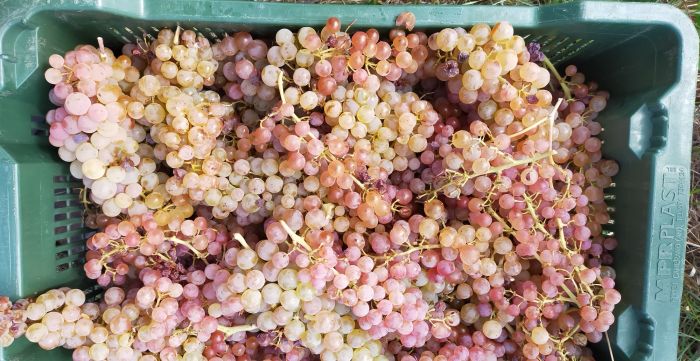
harvest report
07.12.2021
2021 Harvest Report from Mani di Luna
<p>The <glossary term="Harvest" title="521">harvest</glossary> was the longest and most difficult yet; we started on September 3rd with the <glossary term="Sangiovese" title="911">Sangiovese</glossary> for the "Rose Osé" and finished on October 12th with the last grapes of <glossary term="Grechetto" title="505">Grechetto</glossary> to do four days of <glossary term="Maceration" title="610">skin contact</glossary> for "Ametistas".</p>
<p>We had to <glossary term="Harvest" title="521">harvest</glossary> by <span class="zalup"><span><glossary term="Pass" title="1144">passes</glossary><span>,</span></span></span> two or even three times in the same vineyard because of the different <glossary term="Maturation" title="639">maturations</glossary> of the grapes caused by the extreme <glossary term="Drought" title="1167">drought</glossary> conditions and the spring <span class="zalup"><span><glossary term="Frost" title="1135">frost</glossary><span>.</span></span></span> Like always we tried to give the maximum effort and love.</p>
<p>The white grapes <span class="zalup"><span>(<glossary term="Trebbiano/Ugni Blanc" title="1043">Trebbianos</glossary><span>,</span></span></span> <glossary term="Malvasia" title="623">Malvasia</glossary> and <glossary term="Grechetto" title="505">Grechetto</glossary>) brought an abundant <glossary term="Yield" title="1129">yield</glossary> with very healthy grapes while the <glossary term="Sangiovese" title="911">Sangiovese</glossary> had a low <glossary term="Yield" title="1129">yield</glossary> because of the spring <glossary term="Frost" title="1135">frost</glossary> which means few bottles of 2021 reds (we are not making "La Cupa" 2021).</p>
<p>A lot of news about three new wines we will release next year or the year after. </p>
<p>A <glossary term="Sangiovese" title="911">Sangiovese</glossary> red, hand <glossary term="De-stemming" title="378">destemmed</glossary> and <glossary term="Foot-Treading" title="458">foot-trod</glossary> then <glossary term="Vinification" title="1104">vinified</glossary> in two <glossary term="Amphora" title="103">terracotta jars</glossary> of 600L with 7-8 months of <span class="zalup"><span><glossary term="Maceration" title="610">skin maceration</glossary><span>.</span></span></span></p>
<p>A white wine of <glossary term="Procanico" title="829">Procanico</glossary> (Trebbiano Toscana), <glossary term="Riesling" title="858">Riesling</glossary> and <glossary term="Grechetto" title="505">Grechetto</glossary> <glossary term="De-stemming" title="378">destemmed</glossary> and <glossary term="Foot-Treading" title="458">foot-trod</glossary> then <glossary term="Vinification" title="1104">vinified</glossary> in two <glossary term="Amphora" title="103">terracotta jars</glossary> of 600L with 7-8 months of <span class="zalup"><span><glossary term="Maceration" title="610">skin maceration</glossary><span>.</span></span></span></p>
<p>A white wine of <glossary term="Grechetto" title="505">Grechetto</glossary> <glossary term="Fermentation" title="441">fermented</glossary> in a 500L Stockinger Austrian <span class="zalup"><span><span>-</span><glossary term="Oak" title="731">oak</glossary> </span></span><span class="zalup"><span><glossary term="Barrel" title="142">barrel</glossary><span>,</span></span></span> not sure if a sparkling or still wine yet but so far it’s great. </p>
<p>Alessandro,</p>
<p><img src="https://louisdressner.com/uploads/images/article//898/c2/e4/c2e43eca02031e79689dcb9a8e6e197b.jpg" /><img src="https://louisdressner.com/uploads/images/article//898/54/22/54228713ec3b0ba470088f5f17b4bba0.jpg" /><img src="https://louisdressner.com/uploads/images/article//898/40/c3/40c3d30abcdb2e3473bb684de592362d.jpg" /><img src="https://louisdressner.com/uploads/images/article//898/b5/7c/b57c0fcffb6d00a0ea126073e06fb07e.jpg" /><img src="https://louisdressner.com/uploads/images/article//898/09/03/0903de98bd9d249dfa27869396335ffb.jpg" /><img src="https://louisdressner.com/uploads/images/article//898/ed/37/ed37481aa98ff5404c9d0a9b0e2c84e4.jpg" /><img src="https://louisdressner.com/uploads/images/article//898/2d/ac/2dacd9366855f70edfc2459309335bb7.jpg" /><img src="https://louisdressner.com/uploads/images/article//898/56/17/56174bcf54dd730def97b8380e786750.jpg" /><img src="https://louisdressner.com/uploads/images/article//898/d9/af/d9af98140456caa928b4cb18c4352c83.jpg" /><img src="https://louisdressner.com/uploads/images/article//898/ac/bf/acbfa69d252a2699a66109466286095d.jpg" /><img src="https://louisdressner.com/uploads/images/article//898/d6/12/d612e19366afb506b7b759634615696b.jpg" /><img src="https://louisdressner.com/uploads/images/article//898/ca/f8/caf81686c9daaab45d5a40ebc5f2d2fe.jpg" /><img src="https://louisdressner.com/uploads/images/article//898/73/a3/73a3cc6701bd54dcc10b38e21de9eb1a.jpg" /><img src="https://louisdressner.com/uploads/images/article//898/d3/ca/d3ca9525cd412688c22af7dc67b1581c.jpg" /><img src="https://louisdressner.com/uploads/images/article//898/de/08/de085303736c59fd4b11c41b5fbc3b5b.jpg" /></p>
Article
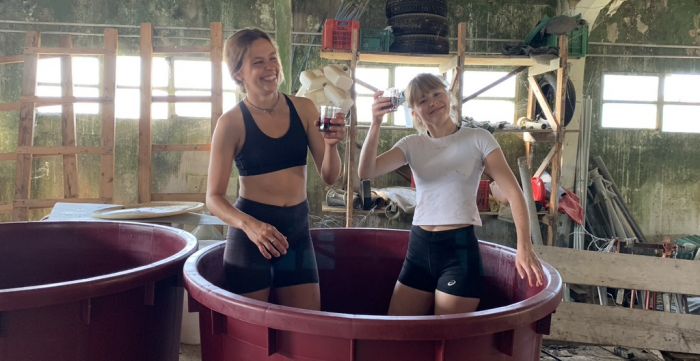
harvest report
19.01.2020
2020 Harvest Report from Rocco
<p><strong><u>November 9th, 2020:</u></strong></p>
<p>Good morning Jules, Denyse and Kevin,</p>
<p>We are fine, in good health, picking the olives...only 2000 plants!<br />
The <glossary term="Vintage" title="1109">vintage</glossary> in this crazy year began on September 2nd and ended on September 30th. The quality of grapes was quite good, as always it was hard work but fun! We stomped on the grapes with our feet while listening and playing music as well! </p>
<p>Our big experiment this year was using the <glossary term="Sangiovese" title="911">Sangiovese</glossary> from our La Cupa vineyard in a 600L <glossary term="Tuscany" title="1055">Tuscan</glossary> <span class="zalup"><span><glossary term="Amphora" title="103">terracotta amphora</glossary><span>.</span></span></span> We <glossary term="De-stemming" title="378">destemmed</glossary> by hand, crushed the grapes by foot and it will stay in <glossary term="Amphora" title="103">amphora</glossary> until April 2021 with all the skin and seeds. It's already tasting great. Maybe a new wine?</p>
<p><img src="https://louisdressner.com/uploads/images/article//869/57/f9/57f94e4e686f9f5a9ceb5743b9f6f8e6.jpg" /><img src="https://louisdressner.com/uploads/images/article//869/9e/03/9e03b93505991ed58abc4ac26fc5074e.jpg" /><img src="https://louisdressner.com/uploads/images/article//869/16/f8/16f831f7471500176427e4b238aae17d.jpg" /><img src="https://louisdressner.com/uploads/images/article//869/9f/c5/9fc585ec6716ac1a9d42678c46cc2466.jpg" /><img src="https://louisdressner.com/uploads/images/article//869/00/57/0057af9680816c6ac24de9749a8c958e.jpg" /><img src="https://louisdressner.com/uploads/images/article//869/00/d6/00d66ce0661e9d77c8277b47bc5bc2ca.jpg" /><img src="https://louisdressner.com/uploads/images/article//869/4f/7e/4f7e8678bcf182294869a61c13794236.jpg" /><img src="https://louisdressner.com/uploads/images/article//869/8d/72/8d72a5c8f59902179c2809b13522dc9f.jpg" /><img src="https://louisdressner.com/uploads/images/article//869/12/b5/12b50f92208fa2d5ca3954b4d7eb3b4d.jpg" /><img src="https://louisdressner.com/uploads/images/article//869/06/53/0653389656d20657a4bc76f4f4895b9d.jpg" /><img src="https://louisdressner.com/uploads/images/article//869/e3/46/e346ea33a01c275e2f922c7f2dac6b48.jpg" /></p>
Article
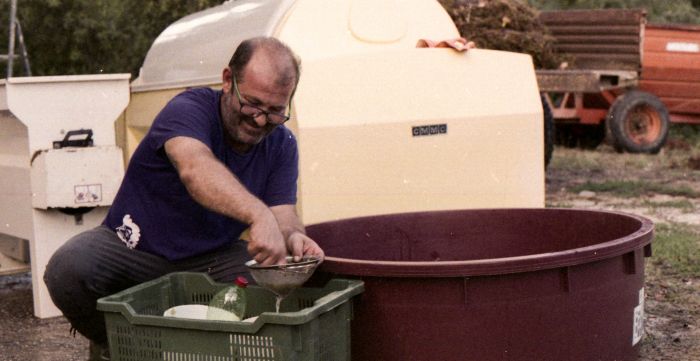
harvest report
16.12.2019
2019 Harvest Pictures from Mani di Luna
<p><img src="https://louisdressner.com/uploads/images/article//839/fb/7b/fb7bbfca6333fafe33c1373bf54088b2.jpg" /><img src="https://louisdressner.com/uploads/images/article//839/9a/7b/9a7b8358cb71cf892b683a7f22bbb670.jpg" /><img src="https://louisdressner.com/uploads/images/article//839/d0/13/d0139030d68df0f999b79467770f5e76.jpg" /><img src="https://louisdressner.com/uploads/images/article//839/bf/e1/bfe1ece4a4f944c571fc27027610baec.jpg" /><img src="https://louisdressner.com/uploads/images/article//839/81/e7/81e7cb0bbc21fd275804e68a6cd32186.jpg" /><img src="https://louisdressner.com/uploads/images/article//839/6a/fe/6afe2a893dcbc8b735008474733f009e.jpg" /><img src="https://louisdressner.com/uploads/images/article//839/94/10/9410a6d741e19de483d2acd4476ce6eb.jpg" /></p>
Article


















